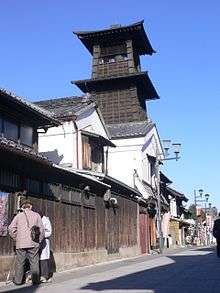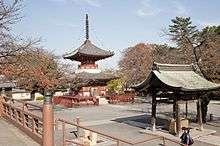Kawagoe
Kawagoe (川越) is an old trading outpost of the ancient capital Edo. Located in Saitama prefecture, the city is now a small suburban city of around 33,000 people, but the preserved warehouse district draws around 4 million visitors to the city each year, and has earned the city the nickname of "Little Edo" (Koedo).

Understand
Tourist Information
- 🌍 Kawagoe Tourist Information Office (川越市観光案内所), 24-9 Wakitamachi (At Kawagoe Station), ☎ +81 49 222 5556. 9:00-16:30.
- 🌍 Nakacho Branch (仲町観光案内所), 2-3 Nakacho. 9:30-17:00.
Get in
By train
Kawagoe Station (川越駅) is a stop on the JR Saikyo Line and the private Tobu Tojo line. From Tokyo the fastest route is the Tobu Tojo line from Ikebukuro, which takes 30mins on the express and costs ¥450. From Omiya the Saikyo line takes 17 mins and costs ¥320.
Hon-Kawagoe Station (本川越駅) is closer to the temple district and is part of the private Seibu-Shinjuku line. Express trains from Shinjuku take 47 mins and cost ¥480.
By bus
Long-distance buses from Kanazawa and Toyama, Limousine Bus Route from Haneda Airport and Narita Airport, Daytime bus service from the Tokyo Disney Resort.
Get around
While it's perfectly feasible to walk around to the main sights, the city also has a network of buses. The most interesting for visitors are the Koedo Kawagoe loop bus, a regular bus that covers all the main attractions in a 40 minute loop, a one day pass costs ¥300. And the vintage Koedo Loop Bus that also loops around the main attractions in about an hour and cost ¥500 for a day pass.
See
Kawagoe is known as "Little Edo" (小江戸 Koedo), after the old name for Tokyo, and its old wooden houses of the Ichiban Gai area, still draw tourists looking for a taste of days gone by.
Warehouse district
Following an event known as the Kawagoe Great Fire in 1893, wealthy traders supplying the old Edo capital with boats down the Shinagashi river, began to reconstruct their warehouse in the Kurazukuri style. While very costly to build, this method of construction - while still looking distinctively Japanese - is made from fire-resistant materials, rather than the clay and wood traditionally used. The buildings are crowned with steep tile roofs featuring immense, fire-deflecting Onigawara (Ogre tiles). Although virtually all of Japan has lost such buildings in the pre world war II era, unusually a preservation movement arose in the town in the mid 1960s, after a great deal of the traditional warehouses had been demolished, to preserve what was left of the historic district, and develop it as an attraction.
Today the warehouse district covers a few 100 square meters, about 1.5 kilometers north of Kawagoe station. While narrow sidewalks along a fairly trafficked road takes away some of the charm, it is still a worthwhile excursion from Tokyo, for those interested in catching a fleeting glance of the elusive "old Japan".
- 🌍 Toki no Kane (時の鐘) (near the Kashiya Yokucho). This bell tower (litt. "Bell of Time") is a famous landmark.
- 🌍 Hattori Museum of Folklore (服部民族資料館), 6-8 Saiwai-cho, ☎ +81 49-222-0337. 10:30-16:00. While there is, in fact, nothing relating to folklore in the folklore museum, the old Hattori family for which is warehouse is named, morphed into a medical company. So you'll find a small display of old medicines, advertisements... and sandals. Free.
- 🌍 Kawagoe Festival Museum (川越まつり会館), 2-1-10 Moto-machi, ☎ +81 49-225-2727. 9:30-18:30. If you don't happen to be in Kawagoe during the yearly festival held in October, you can get a feel for it in this museum, which exhibits the great floats used in the procession and screens a 5 minute movie about the festival. Naturally the museum also details the history of the festival in Japanese. ¥300.
- 🌍 Museum of Kurazukuri (川越市蔵造り資料館), 7-9 Saiwai-cho, ☎ +81 49-222-539. 09:00-17:00. Built after the great fire, in 1893, this old wholesale Tobacco warehouse of the Koyama family, gives you a chance to look inside the warehouses, and learn about the history of Kurazukuri construction. ¥100.
- 🌍 Osawa Residence (大沢家住宅), 1-15-2 Moto-machi, ☎ +81 49-222-7640. 9:30-17:30. Built it in 1792, this warehouse from where the Osawa family traded Miso and Soy, survived the inferno of the great fire, and today stands as the oldest storehouse in Kawagoe. The first floor contains a store while the second floor houses a small exhibition. ¥200.
Other attractions

- 🌍 City Museum (川越市立博物館), 1-20-1 Kosemba-machi, ☎ +81 49-222-5399. 9:00-17:00. Useful after visiting the warehouse district as it contains information on how the warehouses were build. Otherwise your average local museum detailing local history with artifacts and models. Next door is a small art museum with a collection of local art. ¥200.
- 🌍 Kawagoe Castle (Honmaru Goten, 本丸御殿), 2-13-1 Kuruwa-machi, ☎ +81 49-222-5399. 9:00-17:00. Kawagoe's castle dates back to the 15th century, unfortunately the castle was disassembled in the 1870s and only the "Yagura" (tower) and primary hall (Honmaru Goten) still remain. These days the main hall serves as a small museum. ¥100.
- 🌍 Kawagoe History Museum (川越歴史博物館), 11-8 Kubomachi. 10:00-17:00. ¥500.
- 🌍 Kitain temple (喜多院), 1-20-1 Kosemba-machi, ☎ +81 49-222-0859. 9:00-16:00. This temple is notable for its main hall, part of the original the Edo Castle in downtown Tokyo, which was moved here by the Shogun to rebuild the temple after a fire. Also of note is the statues of 540 Rakan, disciples of the Buddha. Free.
- 🌍 Syuuntei Hall (舟運亭むかし館), 1-7-3 Nishikosenbamachi, ☎ +81 49-222-1311. 10:00-18:00. This noodle shop doubles as a small museum with small collection of sketches, documents and edo era tools and armor.
Do
- 🌍 Chiisanatabi Kawagoe Onsen (小さな旅川越温泉), 41-7 Kaminodamachi, ☎ +81 49-249-4126. 10:00-01:00. ¥780-880.
- 🌍 Kasumigaseki Country Club (霞ヶ関カンツリー倶楽部), 3398 Kasahata, ☎ +81 49-231-2181. A golf course.
Buy
Kashiya Yokocho (菓子屋横丁) – This is a traditional shopping district. You can buy many kinds of cheap candies. One of the most popular foods is fugashi. It is very long, like a sword. Its taste is sweet.
- 🌍 Fukazen (フカゼン), 7-4, Saiwaichou, ☎ +81 49-222-1339. 9:30-18:00.
- 🌍 Machikan Knife Shop (まちかん刃物店), 7−3, Saiwaichou, ☎ +81 49-222-1516. Kitchen knife store.
- 🌍 Maruhiro Department Store (丸広百貨店), 2-6-1, Shintomichou, ☎ +81 49-224-1111. 10:00-19:00. Traditional department store.
- 🌍 Matsumoto Soy Sauce Shop (松本醤油商店, Matsumoto Shoyu Shouten), 10-13, Nakacho, ☎ +81 49-222-0432. All kinds of soy sauce, you can taste several. Free visits of the cave every weekday at 1PM.
Eat
.jpg)
.jpg)
Kawagoe is known for its violet sweet potato, which can be eaten as imokenpi (fried sticks), imokoi (potato and red bean in glutinous rice), or ice cream.
- 🌍 Crea Mall (クレアモール), Wakita-machi, ☎ +81 49-225-0269. The shopping strip running between Kawagoe and Hon-Kawagoe stations, offers many of the usual chains and numerous ramen shops. There is a good kaiten sushi place towards the Kawagoe end.
- Koedo. An unagi restaurant that serves sweet-potato beer. This drink is a sweet beer made from the area's famous purple sweet potatoes.
- 🌍 Kashiya-yokocho (Located near Youjyuin Temple.). It was prospering as temple town of Youjyuin and one of the places which started to make dagashi (cheap sweets). In the beginning of Showa period, in its peak, there were about 70 shops. It is still mirthful and selling cheap sweets, and including those made from sweet potato, one of the well-known products of Kawagoe.
- 🌍 Azumaya (東屋), 1-16-1 Nishi-Kosenbamachi, ☎ +81 49-222-0757. Eel kabayaki and more fish. ¥2,000~¥4,000.
- 🌍 Hand made Soba Hyakujyo (手打ちそば 百丈), 1-1-15 Motomachi, ☎ +81 49-226-2616. Buckwheat noodle (soba). ¥1,000~¥2,000.
- 🌍 Fujidana Udon Kawagoe (藤店うどん川越店), 4-1-5 Arajukumachi, ☎ +81 49-247-7887. 10:00-15:00. ¥700~¥1,200.
Drink
- 🌍 Café Colorado (カフェ コロラド), 1-9-12, Shintomicho, ☎ +81 49-226-6705. 7:30-19:00. A coffee shop.
- 🌍 Black tea Roman Maison Shimano (紅茶浪漫館シマ乃 Kocha Roman Kan Shimano), 5-1, Nakacho, ☎ +81 49-222-2715. 9:00-19:00. Specialty black tea shop.
- 🌍 Coffeehouse Jazz (喫茶店 ジャズ Kissaten Jazz), 6-1, Sankubocho, ☎ +81 49-224-0051. 10:00-20:00. Jazz and coffee.
- 🌍 Izakaya Big (居酒屋 大), 18-11, Wakitamachi, ☎ +81 49-225-5519. 15:00-23:30. Japanese-style bar.
- 🌍 Mana Clipper (マナ・クリッパー), Sujino buil B1 11-3, Wakitamachi, ☎ +81 49-290-5094. 17:00-1:00. Many cocktails.
- 🌍 Italian bar Takeya (イタリアン酒場 Takeya), 1-2-1, Shintomicho, ☎ +81 49-225-2220. 17:00-24:00. Wine bar.
Sleep
Most people choose to make Kawagoe a day trip from Tokyo, but there are some options:
Budget
- 🌍 Capsule Inn Kawagoe (カプセルイン川越), 18-3 Wakitamachi, ☎ +81 49-223-3211. If you are looking quickly for a place to spend the night, there is a capsule hotel located near the Kawagoe Train Station that offers rooms for around 3,000 yen per night. The hotel can be easily spotted from the train station by the giant red cap on the top of its building, reading CAPSULE HOTEL in large white letters. The hotel has a sauna, showers, locker rooms, laundry machines, and a lounge. It is staffed 24/7 by Japanese employees and has procedures on hand for English-speaking customers. ¥3500.
Mid-range
- 🌍 Kawagoe Prince Hotel, Shintomi-cho 1-22, ☎ +81 49-227-1111. Includes restaurants and salon.
Go next
- Saitama
- Kawajima
- Tsurugashima
- Hidaka
- Hanno
- Tokorozawa
- Sakado
- Kumagaya
- Chichibu
| Routes through Kawagoe |
| END ← | W |
→ Tokorozawa → Tanashi → Seibu-Shinjuku |
| Yorii ← Higashimatsuyama ← | N |
→ Narimasu → Ikebukuro |
| END ← | W |
→ Ōmiya → Shibuya → Ōsaki |
| Takasaki ← Higashimatsuyama ← Tsurugashima ← | N |
→ Tokorozawa → Tokyo |
| Yokohama ← Sagamihara ← Hachioji ← | W |
→ Ōmiya → Kasukabe → Kashiwa |